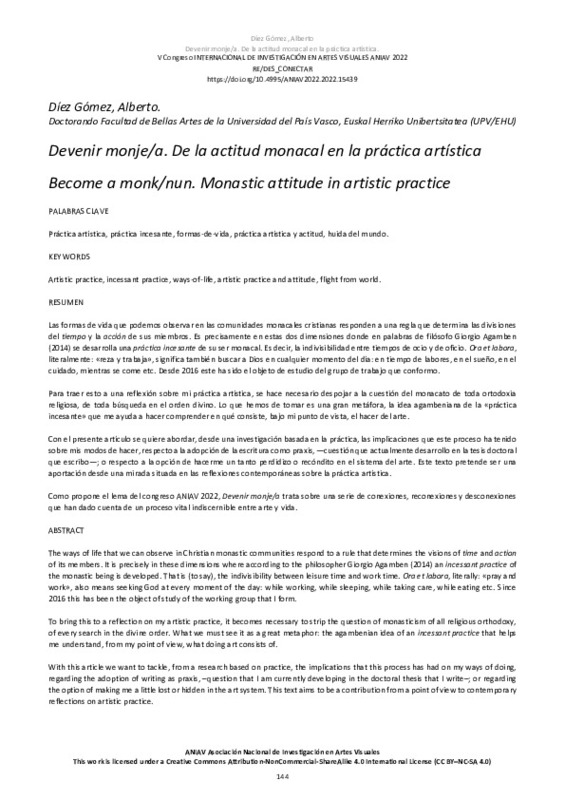|
Resumen:
|
[EN] The ways of life that we can observe in Christian monastic communities respond to a rule that determines the visions of time and action
of its members. It is precisely in these dimensions where according to the ...[+]
[EN] The ways of life that we can observe in Christian monastic communities respond to a rule that determines the visions of time and action
of its members. It is precisely in these dimensions where according to the philosopher Giorgio Agamben (2014) an incessant practice of
the monastic being is developed. That is (to say), the indivisibility between leisure time and work time. Ora et labora, literally: «pray and
work», also means seeking God at every moment of the day: while working, while sleeping, while taking care, while eating etc. Since
2016 this has been the object of study of the working group that I form. To bring this to a reflection on my artistic practice, it becomes necessary to strip the question of monasticism of all religious orthodoxy,
of every search in the divine order. What we must see it as a great metaphor: the agambenian idea of an incessant practice that helps
me understand, from my point of view, what doing art consists of.
With this article we want to tackle, from a research based on practice, the implications that this process has had on my ways of doing,
regarding the adoption of writing as praxis, –question that I am currently developing in the doctoral thesis that I write–; or regarding
the option of making me a little lost or hidden in the art system. This text aims to be a contribution from a point of view to contemporary
reflections on artistic practice As proposed by the motto of the congress ANIAV 2022, Become a monk/nun is about a series of connections, reconnections and
disconnections that have given an account of an indiscernible vital process between art and life.
[-]
[ES] Las formas de vida que podemos observar en las comunidades monacales cristianas responden a una regla que determina las divisiones del tiempo y la acción de sus miembros. Es precisamente en estas dos dimensiones donde ...[+]
[ES] Las formas de vida que podemos observar en las comunidades monacales cristianas responden a una regla que determina las divisiones del tiempo y la acción de sus miembros. Es precisamente en estas dos dimensiones donde en palabras de filósofo Giorgio Agamben se desarrolla una práctica incesante de su ser monacal. Es decir, la indivisibilidad entre tiempos de ocio y de oficio. Ora et labora, literalmente: «reza y trabaja», significa también buscar a Dios en cualquier momento del día: en tiempo de labores, en el sueño, en el cuidado, mientras se come etc. Desde 2016 este ha sido el objeto de estudio del grupo de trabajo que conformo. Para traer esto a una reflexión sobre mi práctica artística, se hace necesario despojar a la cuestión del monacato de toda ortodoxia religiosa, de toda búsqueda en el orden divino. Lo que hemos de tomar es una gran metáfora, la idea agambeniana de la «práctica incesante» que me ayuda a hacer comprender en qué consiste, bajo mi punto de vista, la tarea del arte. Con el presente artículo se quiere abordar, desde una investigación basada en la práctica, las implicaciones que este proceso ha tenido sobre mis modos de hacer, respecto a la adopción de la escritura como praxis, ―cuestión que actualmente desarrollo en la tesis doctoral que escribo―; o respecto a la opción de hacerme un tanto perdidizo o recóndito en el sistema del arte. Este texto pretende ser una aportación desde una mirada situada a las reflexiones contemporáneas sobre la práctica artística. Como propone el lema del congreso ANIAV 2022, Devenir monje/a trata sobre una serie de conexiones, reconexiones y desconexiones que han dado cuenta de un proceso vital indiscernible entre arte y vida.
[-]
|









